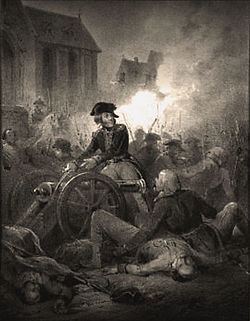2,500 2,000 Date 27 October 1789 | 108 killed60 wounded23 missing3 cannons lost 87 killed or wounded | |
 | ||
Similar Brabant Revolution, Battle of Falmagne, Peasants' War, Battle of Neerwinden, Battle of Jemappes | ||
Battle of turnhout 1789
The Battle of Turnhout (27 October 1789) was a battle which took place in the town of Turnhout (today in Belgium) between Habsburg Austria and a Belgian émigré (Patriot) army commanded by Jean-André van der Mersch which had recently invaded from the nearby Dutch Republic. The battle was one of the pivotal moments of the Brabant Revolution and the Patriots' unlikely victory led to the expulsion of Austrian forces to Luxembourg from the Southern Netherlands for nearly a year.
Contents
Context
The Holy Roman Emperor, Joseph II, was an important figure of European Enlightenment and a believer in reforming institutions he believed to be outdated. As the head of Habsburg Austria and ruler of the Austrian Netherlands, he decreed a wide-reaching programme of reforms. He imposed his own policies in the internal affairs of the Church. Furthermore, he published a number of edicts reforming the law and administration of the territory with the aim of re-enforcing the power of the state.
These laws were received reluctantly by the people and the church, the bourgeois however saw them as an attack on their democracy and civil rights. In response, a movement of protests against Austrian rule appeared. In January 1789, the states of Brabant and Hainaut refused to pay imperial taxes. The Imperial response was an occupation of the County of Hainaut and a suspension of the rights guaranteed to the Duchy of Brabant on 18 June 1789.
Resistance
In May 1789, the secret society Pro aris et focis was founded in Brussels with the aim of gathering resistance against the emperor. At the same time, the Brabançons gathered an army in the United Provinces commanded by Jean-André van der Mersch. The army moved into Hoogstraten in Belgium without meeting severe Austrian opposition. In the town, Henri Van der Noot read the Manifesto of the People of Brabant proclaiming the end of Austrian control of the Southern Netherlands. Van der Noot proclaimed that the attack on southern Netherlands was a reaction to the Austrian Emperor who had not complied with the rights guaranteed by the Joyous Entry of 1356.
Battle of Turnhout
In October 1789, one of the two "divisions" of the patriotic army marched towards Brabant. It arrived in, and easily captured, Turnhout on the 25th. They had just left the town when they were informed that an Austrian force was moving towards them. Van der Mersch knew that a battle in open country would be futile and decided that his best chance would be to hold the town and fight in the streets, reducing the numerical advantage of the Austrian forces.
With the help of Emmanuel-Joseph Van Gansen, son of a brewer in Westerlo, the inhabitants of the town threw up baracades in the streets. A group took position in the square and another at the entrance to the town near a mill. The town of Turnhout was besieged by the Austrians on the 27th October and a violent combat took place. As van der Meersch had hoped, the Austrian forces were not well prepared for fighting in the town itself and, after five hours of fighting, they were forced to retreat, leaving behind five cannons.
Aftermath
News of the victory at Turnhout spread over the Flanders and Brabant and resistance increased. The Brabant Revolution became a reality. The towns of Ghent, Diest, Tirlemont and Brussels fell to the rebels. Austrian forces withdrew to the Duchy of Luxembourg.
On December 31, Brabant declared its own independence and was joined, in January 1790, by many other Belgian states leading to the creation of the United Belgian States.
Commemoration
Each year in the Turnhout battle is commemorated with a spectacle in the Gasthuisstraat, the location where the fighting was fiercest. A memorial by P. Brozius in the Market of Turnhout recalls this battle. The stone dates from 1889, on the occasion of the celebration of 100 years Battle of Turnhout.
